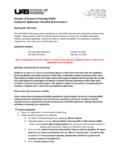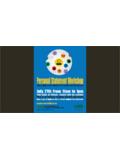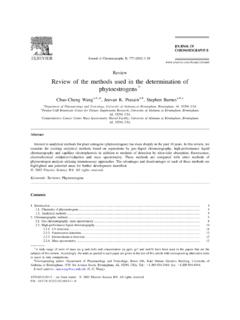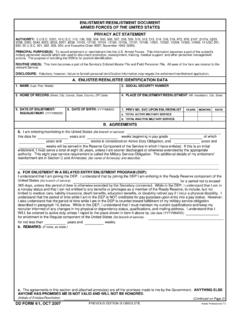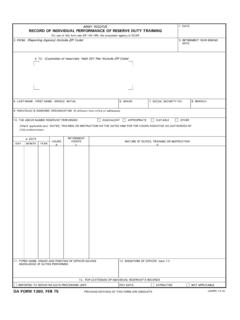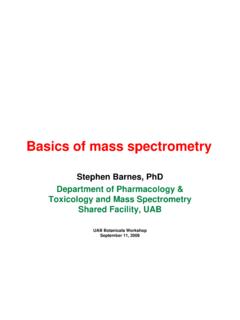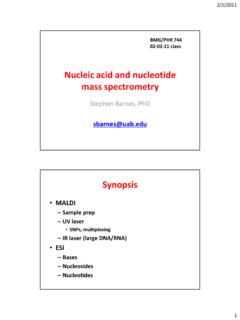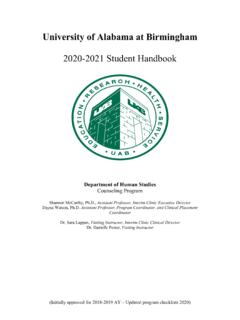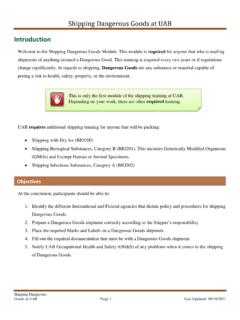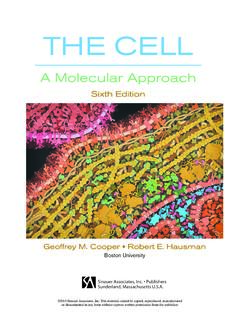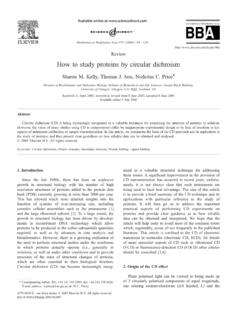Transcription of ASSAY DEVELOPMENT IN DRUG DISCOVERY
1 ASSAY DEVELOPMENT IN DRUG DISCOVERYI ndira Padmalayam, DISCOVERY Division, Southern Research Institute, Birmingham, Alabama 35205 The Drug DISCOVERY Process:The ASSAY DEVELOPMENT StageAssay developmentPrimary assays Secondary assaysTarget IdentificationTarget ValidationAssayDevelopmentHTSLead IdentificationLead OptimizationDevelopment Hit validationChemistryStructure-Activity Relationship (SAR)bioavailability (PK, ADME), toxicityIn vivo efficacyPre-clinicalGLP-ToxClinicalTarge t IdentificationTarget ValidationAssayDevelopmentLead Optimization DevelopmentHTSNon-HTSA ssay DEVELOPMENT : A critical part of the hit DISCOVERY process HITS A hit is a compound which has the desired activity in acompound screen and whoseactivity is confirmed upon retestingAdapted frrom: Hughes, (2011), British Journal of Pharmacology, 162 1239-1249 Secondary assaysPrimary assaysAssay DevelopmentPre-Roadblocks to faster ASSAY DEVELOPMENT Why is this a bottleneck?
2 ASSAY DEVELOPMENT =monthsHTS=weeksDrug DISCOVERY World, Summer 2010 Topics to be covered Paradigms in Drug DISCOVERY Significance of ASSAY DEVELOPMENT in Drug DISCOVERY ASSAY types ASSAY formats Optimizing assays for HTSF actors to be considered (will be covered in detail in HTS lecture) ASSAY DEVELOPMENT examplesParadigms in Drug DiscoveryPhysiology-basedTarget-basedTar get is unknownPhysiological/phenotypic read-outsCell-based assays Known targetRead-outs are based on activity or expression of targetBiochemical or Cell-based assays The two paradigms are not mutually exclusive: Drug DISCOVERY programs can use two-pronged drug discoveryExample : Viral CPE (CytopathicEffect) assayGreen: uninfected cellsRed: host cells+virusBlue: host cells+virustreated with an antiviral compound, RibavarinSlide:courtesy, Jim Noah, SRI1815S1S3S5S7S9S11S13S15S17S19S21S2302 0000400006000080000100000120000140000 Influenza CPE ASSAY - Preliminary CV PlateHost cell viabilityTarget-based Drug DiscoveryScience, 2000 Enzymes: KinasesReceptor Tyrosine KinaseNon-receptor tyrosine kinaseSerine Threoninekinase Phosphatases Proteases:Serine proteasesZinc proteases Receptors:Ion channel receptorsGPCRsNuclear receptorsAssay DEVELOPMENT for Drug DISCOVERY Target identified ASSAY DEVELOPMENT HTSand Validated To ensure successful ASSAY DEVELOPMENT : -Ask the right question (the biological problem being addressed)-Make sure that the wording of the question is correct(choose the correct ASSAY , read-out and sequence of assays).
3 Key we trying to inhibit or activate the target? function of the target are we trying to regulate? are the types of assays that are available to measure the function? ASSAY vsSecondary ASSAY will work best in terms of translatability to are the post-HTS assays that will drive Structure Activity Relationship (SAR) Key Considerations in ASSAY DevelopmentThe three Rs -Relevance-Robustness-Reliability/Reprod ucibilityCost The quality of an ASSAY determines the quality of the data: compromising on ASSAY DEVELOPMENT can have substantial downstream consequences Practicality/FeasibilityAutomationTypes of AssaysAssays in Drug DiscoveryBiochemical assaysCell-based assaysTarget-basedPhenotype-based Measure function of a purified targetActivity assays: Enzymes ( kinases, proteases) binding assays: Receptors ( Nuclear receptors, Kinase receptors, ion channels, GPCRs) Identify compounds that modulate activity / binding of the target proteinRecombinant (engineered) proteins, proteins isolated from crude cell lysatesMonitor a surrogate read-out Examples: Kinase/ATPase assays, protease assays, protein interaction assays Measure function of the target in the context of the cell-Transcriptional read-outs, second messenger levels,cell viability (cell death/apoptosis), proliferation Measure expression of the targetmRNA levels, protein expression and localization Provide a functional read-out of compound activity (as a functional consequence of target engagement) Examples: reporter assays, viability assays, GPCR and ion channel assays, qPCRB iochemical versus Cell-based assays Advantages.
4 -More physiological, amenable to systems approach-Can simultaneously ASSAY for compound properties(membrane permeability, toxicity, off-target effects) Disadvantages: -Complex-High rate of noise -Exclusion of less soluble/permeable compounds Advantages: -Simple-More consistency-Direct measurement of target engagement-Can measure compound characteristics such as Kd, specificity of compounds Disadvantages:-May be non-physiological-Not possible to determine compound properties such as membrane permeability, toxicity, off-target effectsCell-based assaysBiochemical assaysCauses of ASSAY VariationBiochemical Assays pH Temperature Ion concentration Reagent Solubility Reagent Stability Reagent Aggregation Order of reagent addition InstrumentationCell Based Assays Same as for biochemical assaysPlus: Cell culture plastics Culture media Culture conditions Serum Cell cycle Passage numberCommon ASSAY formats Fluorescence LuminescenceFluorescence-based assays Based on excitation of a fluorophore Variety of assays using fluorescence-Simple assays where protein of interest is conjugated to fluorophore, or where the protein of interest generates a fluorescent product-Reporter assays-Advantages:High sensitivity, ease of set-up and operation-Disadvantages: Prone to false positives due to auto fluorescence of compoundExamples: -FRET, TR-FRET-Fluorescence polarization (FP)1 to 10 nanosecsFluorescence-based assays (contd.)
5 FRET: Florescence Resonance Energy TransferHalf life: 1 to 10 nanosecs Principle: Two fluorophores: Donor and Acceptor-Based on transfer of energy between donor and acceptor-Distance is criticalFar: No energy transfer no FRETC lose: Energy transfer from donor to acceptor FRET Use: Protein-protein, antigen-antibody, DNA-DNA, DNA-protein Advantages: -Homogenous ASSAY format-Reduced ASSAY time and cost (HTS friendly) Disadvantage: -Short half life of fluorophoreresults in high backgroundFluorescence-based assays (contd.) Improved versionof FRET-Uses long lived fluorophoresand time-resolved detection to reduce backgound-Rare earth elements (Lanthanides): Samarium (Sm), Europium (Eu),Terbium (Tb), and Dysprosium (Dy) Advantage:-Low background; better signal to noise Disadvantage: -Lanthanides have poor ability to absorb light, so have to be complexedwith organic moieties that can harvest light and transfer it to : Time Resolved-Florescence Resonance Energy TransferFluorescence-based assays (contd.)
6 Principle:Small, unbound fluorophore: fast rotation, light is emitted in a plane different from excitation to protein: Slow rotation, light is emitted in the same plane as excitation light. Applications:Study molecular interactions protein-protein, receptor-ligand, DNA-protein, tyrosine Kinase assays. Advantages: Highly sensitive (low picomolarrange), homogenous assays, multiple measurements can be made on the same sample, because there is no change in samples during the ASSAY . Disadvantage: More optimization of ASSAY may be needed to ensure saturation of all target binding sites with the fluorophore-labeled ligand (to ensure displacement by unlabeled ligand)Fluorescence Polarization (FP) assayFluorescence-based assays (contd.)Un-labeled compoundsATP binding pocketCy3 labeled compoundFPreadFP assayScreenLuminescence-based assays Chemical reaction produces light Bioluminescenceis the production and emission of light by a living organism ( luciferaseby firefly)Luciferin+ ATPL uciferyladenylate+PPiLuciferyl+ O2 AdenylateOxyluciferin+AMP +LightLuciferaseExample: Luciferase reporter ASSAY :Examples of biochemical assaysAssay for kinaseactivityADP Hunter assayKinasetargetSubstratePhosphorylated Substrate+ ADPF luorescent productKinasetargetSubstrateInhibitorsPh osphorylated Substrate+ ADPF luorescent productReduced signalAssay for protein-protein interactionAlphaScreentechnologyAmplifie d Luminescent Proximity Homogenous Assay4 sec4 sec200 nmBAAlpha Donor BeadAlpha Acceptor BeadEmission at 520-620 nmExcitation at 680 nm1O2 AlphascreenAssay.
7 Measuring Tau-Fyn interactions in Alzheimer s disease Interactions between Tau and Fyn are implicated in Alzheimer s disease Donor bead labeled with glutathione Binds to Fyn-GST Acceptor bead chelatedto nickel Binds to a His-tag on Tau proteinFigure: Courtesy Erik Roberson, ADDA Tau-Fyn project Examples of cell-based assaysCell based assays ProliferationFluorescent dyes Viability-Assays that measure ATPcontent (Cell Titer Glo), viral CPE (bioluminescence-based)-Apoptosis assays(bioluminescence/fluorescence) Migration-Scratch ASSAY Reporter Gene assays-Transcriptional activity/expressionCell Proliferation(non-specific dye) Cell migration scratch ASSAY 1815S1S3S5S7S9S11S13S15S17S19S21S2302000 0400006000080000100000120000140000 Influenza CPE ASSAY - Preliminary CV PlateCell viability(CPE ASSAY )Assays for G protein-coupled receptors (GPCRs) GPCRs are the targets for majority of best-selling drugs and approx 40% of prescription drugs ( Zantac, Clarinex, Zyprexa) GPCRs are proteins with 7 transmembranedomains ASSAY will depend on the type of GPCR being targeted.
8 3 type of G proteins (Gs, Gi/G0and Gq) Non-G protein mediated responses( -Arrestinrecruitment) Assays are designed to measure second messengers such as cAMP, Ca2+ Measurement of proximal or distal responses HTS friendly assaysHigh Content Screening High content screens: Facilitates validation of effects of compounds at the cellular and subcellular level (expression, localization, morphological changes in cells) Macromolecules ( proteins, RNA) are labeled with fluorescent tags Technology uses automated digital microscopy, flow cytometry and IT-systems for analysis and storage of data Slower than HTS Popular as secondary screens in drug DISCOVERY programs10 M1 MMDA-MB-231 breast cancer cells were co-cultured with 3T3L1 fibroblasts and treated with Cytochalasin-D, an inhibitor of actin polymerization. Migration of cells through the matrigellayer was measured at various heights of the Z stackCytochalasin-D concentration response on cell migration Example 1:Cell migration assays: (uM)% InhibitionCytochalasin-D 48hrsIC50 = Invasion Ratio High Content Screening in Drug Discovery5 nMDMSO20 nM80 M M 5 M10 M0100200300400500600700800 Mean total neuritelength per cell ( m)050100150200 Mean length of longest neuriteper cell ( m)20 MHigh Content Screening in Drug DiscoveryExample 2:NeuriteOutgrowth ASSAY : Alzheimer s diseaseA concentration response on neuriteoutgrowthAssay DEVELOPMENT : From the bench to HTSFrom This To This When you go THE RULES CHANGEE verything is done in Microtiter Plates96, 384, 1536, 345696-well100-200 l384-well25-50 l1536-well4-10 l3456-well1-2 l What are you aiming for in an HTS ASSAY .
9 To have a reasonable chance, to believe the results of a single determination, one well For that you need: Reproducibility from well to well Reproducibility from ASSAY plate to ASSAY plate Reproducibility from day to day How do you know if your ASSAY is ready for HTS? ASSAY DEVELOPMENT : From the bench to HTS (HTS 101) ASSAY DEVELOPMENT : From the bench to HTSASSAYQC PARAMETERS Z factor: Key measure of readiness of an ASSAY for HTS Z > Coefficient of variance (CV) : Measure of dispersion Signal to background (S/B) and Signal to noise (S/N):Measures of signal strengthS/B = Mean of sample S/N = Mean of sample-Mean of controlMean of control Standard Deviation of control3SD of sample + 3SD of controlmean of sample mean of controlZ= 1 % CV =SD X 100 MeanWill be covered in HTS lecture next weekASSAY DEVELOPMENT CASE STUDIESCase 1:Identification of a small molecule inhibitor of mitotic spindle bipolarityIdentification of Monastrol,inhibitorof mitotic kinesin, Eg5 Mayer, TU eta al, Science286, 971-974 (1999)Primary ASSAY : Phenotype-basedCounterscreenSecondary ASSAY : To select mitosis inhibitorsCASE 2.
10 Identifying compounds that inhibit TXNIP expressionAssay developmentPrimary and secondary assaysHTS primary screen(single dose) Hits Hit validation and determination of potency (IC50)(counter screens, concentration response curves)Secondary phenotypic assaysHit validation and determination of potency1. Cytotoxassay to eliminate compounds with toxicity2. Concentration response in primary ASSAY for potency (IC50)3. Chemistry analysis to identify scaffolds of interestCounter screen: To eliminate non-specific luciferase inhibitorsPrimary HTS ASSAY : Luciferase reporter ASSAY with TXNIP promoterHTS primary screen: 10K pilot screen followed by 300K full screen(single dose) 3000 Hits Chemistry analysis 1258 Hits 651 Hits 157 Hits Secondary ASSAY : TXNIP qPCR37 Hits Test in other confirmatory assays at UABADDA project: TXNIP as a target for diabetesTXNIP = Thioredoxin-interacting protein 13 Hits CASE 3:Identifying compounds that activate HO-1 expressionHit validation and determination of potency1.
